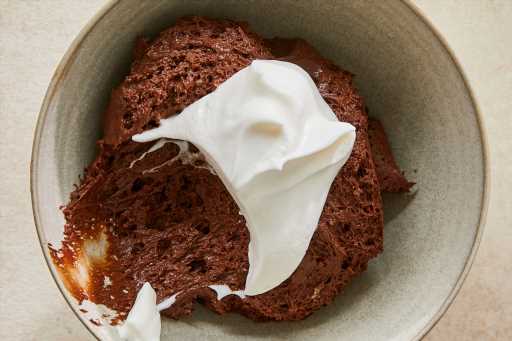Chocolate mousse recipe: The secret to summer’s best no-sweat dessert – The Denver Post
By Genevieve Ko, The New York Times
I didn’t fully understand the appeal of chocolate mousse until a decade ago, when I had it at the home of my friends Cecile and Tom Renna. They hosted brunch on a July afternoon so oppressively humid, I couldn’t imagine eating much at all.
But then Cecile brought out two big metal bowls — one piled with chocolate mousse, the other with whipped cream — so chilled from the refrigerator that they immediately began sweating as much as we were.
Cool, silky and so light, the mousse was perfect for the hot weather. It disappeared in your mouth like cotton candy but delivered a deep chocolaty flavor. And the casual way Cecile served her dessert — family-style for us to scoop straight out of the mixing bowls — made it feel as fun and welcoming as birthday cake.
Chocolate mousse can seem intimidating because it is often layered into martini glasses and crowned with chocolate curls in formal dining rooms. But in France, where Cecile grew up, it carries the low-key familiarity of our chocolate chip cookies. She has been making mousse since childhood and now loosely follows the instructions on the back of a “cheap” French Nestlé dark chocolate bar. “It’s the recipe that everyone makes in France,” she said.
Someone ladled out seconds, revealing a bright cloud of whipped egg whites that hadn’t been incorporated into the chocolate. Instinctively, I tensed. At the restaurant kitchens where I had worked, the chefs would have whisper-screamed about how unacceptable it was (in more colorful language).
Instead, Cecile glanced at the pupil of egg white surrounded by its chocolate iris and laughed. She preferred it this way, she said with a nonchalant confidence, adding that it was better to have pockets of egg whites than to fold them in so thoroughly that the mousse deflates.
When I asked her about her perfect-is-the-enemy-of-good approach to mousse all these years later, she said, “The moment you’re afraid of doing something, it paralyzes you.”
But there is nothing to fear about making mousse, especially since there are endless variations on it. The word loosely translates to “foam,” and that is the one thing it needs. “Larousse Gastronomique,” the culinary tome, describes it broadly as a “light, soft preparation.” That lightness can come from eggs, cream or, simply, air, as is the case with the chocolate-only version from molecular gastronomist Hervé This.
Making an Unfussy Dessert
Most mousse recipes follow some basic steps: melting chocolate, then folding in foamy egg yolks, whites or both and sometimes whipped cream. Many enhance the mix with coffee, alcohol, spices or other seasonings. In “Mastering the Art of French Cooking,” Julia Child calls for beating egg yolks at room temperature, then over steaming water, then over cold water, before also beating egg whites. She also melts an astonishing amount of butter into the chocolate, as does Ina Garten, a generation later.
In The New York Times, Craig Claiborne and Pierre Franey shared their “ne plus ultra” formula, which involves a folding a sabayon (a custardy dessert sauce of egg yolks and liquor), then sweetened whipped cream, then stiff egg whites into chocolate.
The thing with chocolate mousse is that any type is going to be delicious as long as it’s smooth and airy. I wanted to create a version that captured the laid-back spirit of Cecile’s — both in the cooking and in the sharing. To taste the effects of different ingredients in varying proportions and understand potential pitfalls, I experimented with nearly 20 variations to land on a formula that combines simple pleasures and easy preparation. There are some key steps to achieving it.
Extra-Airy Egg Whites: Mountains of peaked egg whites were a given, as egg whites provide the airiest foam and are easy to beat with an electric mixer, ideally a standing one. To ensure that they stiffen, the mixer bowl needs to be clean, and the whites can’t have a trace of yolk. If you are worried about your egg-separating skills, drop each egg white into a separate small bowl first before slipping it into the mixer bowl. This way, if you have, say, five perfect whites in the mixer bowl and you mess up the sixth one, you won’t have to start all over.
The whites can then be beaten — at medium speed for the most stable foam — until they are so stiff that peaks form and hold in the bowl and at the end of the whisk. There shouldn’t be any liquid at the bottom of the bowl, but the whites also shouldn’t be dried out from overbeating. Whisking in some sugar helps keep them glossy, too.
Just-Right Richness: After testing versions with yolks beaten until voluminous, I found that whisking them added lift, but not enough to justify the time and extra dishwashing. Not to mention, the taste of eggs came through too strongly when the yolks were beaten first. Simply stirring them in resulted in a richness that didn’t interfere with the flavor of the chocolate.
Butter also offered richness, but it was a little too much for a summer dessert, making the mousse denser, like a chocolate truffle. For a just-right creaminess, heavy cream softens the bitter edge of chocolate. Whipping it before adding also lends a touch of fluffiness, but nailing the temperature is tricky. Too cold, and it can cause the chocolate to solidify in tiny lumps; not cold enough, and it will just liquefy.
Following a tip from a French chef’s grandmother, I melted the chocolate with the cream. This not only lent a gentle milky flavor, but it also helped prevent the chocolate from seizing and becoming gritty. So did adding the yolks while the chocolate was still warm. The fat in both the cream and the yolks may cause the mixture to look broken, but whisking it gently off the heat can bring it back together. A splash of cold cream can, too. If the blend still looks a bit separated, it will smooth with the addition of the whites, and the end result will be silky.
Smart, Gentle Folding: A dollop of the whites is stirred into the chocolate first to loosen the mix, which means you can fold in the rest of the whites with the gentlest touch to ensure the foamiest mousse. As for folding, it is just what it sounds like: You want to pick up and fold the heavier chocolate at the bottom of the bowl over the weightless whites on top. And you want the two to blend in the fewest folds possible to keep all the air trapped in the whites intact.
It also helps to rotate the bowl in the opposite direction of your spatula as you swipe the chocolate up and over the whites. So, for example, if you are running your spatula from 6 o’clock to 9 o’clock, you then want to turn your bowl counterclockwise. It is not necessary, but it is worth trying if only because of how meditative it feels and looks, the zebra swirls fading into a beautiful brown.
Whether you consider chocolate mousse easy depends on your experience and comfort level with making dessert, but these tweaks and tips can guarantee a bowl of goodness. Once you get the hang of it, you can whip it up in less than 20 minutes. It won’t be a proper mousse until it is chilled, and it is far better after 24 hours in the refrigerator, but that is what makes it the most stress-free party dessert. Prepare it the day before guests arrive, and pull it out when it is time to eat.
But what really makes this a relaxing dish is the approach Cecile recommends: Try it without fear, and don’t worry if it is not flawless. About mousse — and maybe more — she said: “You cannot control everything. The moment you let it go, it makes life so much easier.”
Recipe: Chocolate Mousse
By Genevieve Ko
Each mouthful of this dessert is a marvel: as light as a meringue pie topping, but with the eggy silkiness of a creamy chocolate custard. This mousse has a particularly airy texture, but it is still a little rich from the bittersweet chocolate, which makes it the ideal not-too-sweet dessert. Because the mousse develops an even deeper flavor over time, it is perfect for parties. You can make it up to five days ahead of time and serve it straight from the refrigerator.
Yield: 8 to 10 servings
Total time: 20 minutes, plus overnight chilling
Ingredients
- 1/2 cup/120 grams heavy cream, plus more if needed and for serving if you’d like
- 12 ounces/340 grams bittersweet chocolate, coarsely broken or chopped (see Tip)
- 8 large egg whites (265 grams/1 cup)
- 1/4 cup/50 grams granulated sugar
- 4 large egg yolks (56 grams)
- 1 teaspoon pure vanilla extract
Preparation
1. Bring an inch of water to a boil in a medium saucepan. Combine the cream and chocolate in a large heatproof bowl. When the water boils, turn the heat to low so the water is barely simmering or just steaming. Set the bowl over the saucepan and melt the chocolate, gently stirring with a whisk now and then.
2. While the chocolate melts, whisk the egg whites in a clean bowl using a stand mixer or electric hand mixer on medium speed. When the whites are foamy, add the sugar in a slow stream while whisking. Continue whisking until stiff peaks form. The whites should look glossy but not dry, and, when you lift the whisk from the mixture, a peak should form in the bowl and hold.
3. Once the chocolate has melted completely, turn off the heat but leave the bowl over the saucepan. Holding the bowl with a kitchen towel, add the egg yolks one at a time, whisking after each addition. If the mixture looks broken, remove the bowl from the saucepan, cool for a minute, then add 1 tablespoon cream and whisk just until shiny and smooth. Whisk in the vanilla. (Don’t worry if it still doesn’t look completely smooth. It will come together in the next step.)
4. Add a quarter of the beaten whites to the chocolate mixture and stir gently with a flexible rubber spatula until incorporated but still a little streaky. This will make it easier to fold in the remaining whites to create an airy mousse by gradually lowering the temperature of the chocolate (tempering) and making the mixture loose.
5. Add the rest of the whites and fold them in by running the spatula from 12 o’clock on the bowl to 6 o’clock, then scooping up the chocolate on the bottom and gently folding it over the whites as you move toward 9 o’clock. Rotate the bowl 90 degrees and repeat. Continue folding just until the last streak of white disappears. It is OK if there are a few lumps of whites left. It is better to not deflate the batter by folding too much.
6. Scoop into a pretty bowl or into individual cups or bowls for serving if you would like. Otherwise, keep it in the mixing bowl. Refrigerate the mousse uncovered until cool, then cover and refrigerate for at least four more hours and preferably 24. The covered mousse can be refrigerated for up to five days.
7. If you would like to serve the mousse with whipped cream, whisk heavy cream until soft peaks form. A cup or two of heavy cream is plenty for this amount of mousse. Serve the mousse cold, straight from the refrigerator, with the whipped cream.
Tips:
Use chocolate meant for eating or for making confections, not baking chocolate, which has a higher proportion of cacao solids and results in a dense and possibly gritty mousse. Chocolate with 70% to 74% cacao is ideal, but choose your favorite. This will taste best with whichever bar of chocolate you enjoy eating on its own.
This article originally appeared in The New York Times.
Subscribe to our weekly newsletter, In The Know, to get entertainment news sent straight to your inbox.
Source: Read Full Article



